Knowledge Representation and Reuse of Ship Block Coating Based on Knowledge Graph
Abstract
:1. Introduction
- Detailed investigation and research have been conducted on the ship coating process.
- Modeling and construction of a KG for the ship coating process for the first time, with the introduction of temporal characteristics.
- The importance formula was first proposed, transforming objective numerical values into a judgment matrix.
- Based on the contribution degree of each item in the joint distance metric, the AHP is applied to improve the KEQA algorithm framework.
- The first construction of a ship block coating dataset.
2. Determination of Research Objectives
2.1. Ship Block Coating Process
- Starting from the material yard, the steel surface is pretreated and coated with shop primer paint before the coating is applied.
- The most important secondary descaling and coating operations of the blocks are carried out after combination into blocks.
- Perform secondary descaling and coating operations on the block assembly.
- Area coating, including the deck, the quay, and the dockyard before delivery.
- Coating of outfitting parts always.
2.2. Data Analysis of Ship Block Coating
- (1)
- Static data: the term static data refers to data that are not time-dependent regardless of the type of block being coated. These types of data encompass various aspects, including planning for the coating operation stage, pretreatment procedures prior to coating, materials and equipment involved in the coating process, and coating methods and associated procedures, as well as quality inspections conducted after coating. Static data serve primarily for the analysis and evaluation of coating quality, optimization of the coating process, formulation of coating standards, and other related tasks. By analyzing static data, potential issues in the coating process can be identified, enabling appropriate adjustments and enhancements to be implemented. Figure 2 illustrates the static data involved in the ship coating process.
- (2)
- Temporal data: temporal data pertain to information that undergoes changes over time during the block coating process. This category of data includes various elements such as planned task durations, coating progress, real-time monitoring of environmental parameters, presence of harmful substances, spraying parameters, paint rheological properties, paint drying time, coating thickness, and additional data details. Real-time analysis of temporal data allows for monitoring changes within the coating process, thereby ensuring the stability and consistency of coating quality. The specific content and accompanying comments for the temporal data are outlined in Table 1.
3. Definition and Construction of TKG
3.1. Definition of TKG for Ship Block Coating
3.2. Construction of TKG for Ship Block Coating
3.2.1. Theoretical Framework
3.2.2. Ontology-Based Knowledge Modeling for Ship Block Coating
3.2.3. Construction of KG for Ship Block Coating
4. Improving KEQA Based on AHP
4.1. KEQA Framework
- The KEQA utilizes embedding representations to train a relationship learning model, which takes the problem as input and predicts relationship representations in the KG embedding space as output. In a similar manner, a head entity learning model can be constructed to predict the head entity representation of the problem.
- Given the typically large number of entities in a KG, the KEQA designs the head entity detection model to reduce the number of candidate head entities. Several head entity tokens in the problem are identified as predicted head entity names, and then the search space is reduced from whole entities to multiple entities with the same or similar names.
- In designing the relation function within the KG embedding algorithm, the computation of the tail entity representation for the prediction problem is performed. Ultimately, based on the designed joint distance metric, the closest fact of the predicted facts in the KG is returned as the answer.
4.2. KEQA Model Based on Bi-LSTM
4.2.1. Head Entity and Relationship Learning Models
4.2.2. Head Entity Detection Model
4.3. Joint Distance Metric Based on AHP
4.3.1. Calculation of Significance
4.3.2. Calculation of Predefined Weight
- Each column element of the judgment matrix is normalized to obtain the matrix M. The formula is as follows, where is the element in the corresponding position in matrix M.
- Summing by rows yields vector K, which is calculated as follows, where is the element at the corresponding position in vector K.
- Normalize vector K to obtain the weight vector, W. The formula is as follows, where is the element at the corresponding position in the weight vector, W.
- Calculate the maximum characteristic root, and carry out the consistency test. The formula is as follows, where C.I. is the consistency index, R.I. is the random consistency index, and C.R. is the consistency ratio. R.I. is obtained by checking Table 6, and the consistency test passes when the final obtained consistency ratio C.R. < 0.1.
5. Verification of Ship Block Coating QA-KG Based on AHP-KEQA
| Algorithm 1: The proposed AHP-KEQA framework |
| Input: KG, E, R, Q, entities, relationships, questions. |
| Output: head entity and relationship |
| / * Training the relationship learning model: */ |
| 1 for questions in Q do |
|
|
| / * Training the head entity learning model: */ |
| 4 for questions in Q do |
|
|
| / * Training the HED model: */ |
| 7 for questions in Q do |
|
| /* Question answering processes: */ |
| 10 Input Q into the relationship learning model to learn ; |
| 11 Input Q into the head entity learning model to learn ; |
| 12 Input Q into the HED model to learn and ; 13 Find the candidate fact set C from KG, based on ; |
| 14 For all facts in C, calculate the fact , weight matrices and minimizes the objective function in Equation (17) |
5.1. Experimental Design
5.1.1. Datasets
5.1.2. Evaluating Indicator
5.2. Effectiveness of AHP-KEQA
6. Conclusions and Future Prospects
Author Contributions
Funding
Institutional Review Board Statement
Informed Consent Statement
Data Availability Statement
Conflicts of Interest
Abbreviations
| KG | Knowledge graph |
| TKG | Temporal knowledge graph |
| KEQA | Knowledge embedding question answering |
| AHP | Analytic hierarchy process |
| AHP-KEQA | KEQA method improved by the AHP |
| CNN | Convolutional neural network |
| LSTM | Long short-term memory network |
| Bi-LSTM | Bidirectional long short-term memory network |
| QA-KG | Question answering based on the knowledge graph |
References
- Dev, A.K.; Saha, M. Analysis of Hull Coating Renewal in Ship Repairing. J. Ship Prod. Des. 2017, 33, 197–211. [Google Scholar] [CrossRef]
- Otter, T. DOOML: A New Database & Object-Oriented Modeling Language for Database-Driven Web Application Design and Development. Int. J. Softw. Eng. Appl. 2022, 13, 23–31. [Google Scholar] [CrossRef]
- He, B.; Deng, Z.; Lv, H. Object-oriented Knowledge Modelling for Conceptual Design of Mechanisms. Int. J. Database Theory Appl. 2013, 6, 67–84. [Google Scholar] [CrossRef]
- Bolbakov, R.G.; Sinitsyn, A.V.; Tsvetkov, V.Y. Onomasiological modeling in the information field. J. Phys. Conf. Ser. 2022, 2373, 022010. [Google Scholar] [CrossRef]
- He, Y.; Hao, C.; Wang, Y.; Li, Y.; Wang, Y.; Huang, L.; Tian, X. An ontology-based method of knowledge modelling for remanufacturing process planning. J. Clean. Prod. 2020, 258, 120952. [Google Scholar] [CrossRef]
- Zhong, S.; Wen, Y.; Huang, Y.; Cheng, X.; Huang, L. Ontological Ship Behavior Modeling Based on COLREGs for Knowledge Reasoning. J. Mar. Sci. Eng. 2022, 10, 203. [Google Scholar] [CrossRef]
- Eichler, R.; Giebler, C.; Gröger, C.; Schwarz, H.; Mitschang, B. Modeling metadata in data lakes—A generic model. Data Knowl. Eng. 2021, 136, 101931. [Google Scholar] [CrossRef]
- Arora, V.; Ventresca, M. Action-based modeling of complex networks. Sci. Rep. 2017, 7, 6673. [Google Scholar] [CrossRef]
- Zhao, J.; Deng, Y. Complex network modeling of evidence theory. IEEE Trans. Fuzzy Syst. 2020, 29, 3470–3480. [Google Scholar] [CrossRef]
- Chen, L.; Yu, X.; Sun, C. Characteristic modeling approach for complex network systems. IEEE Trans. Syst. Man Cybern. A 2017, 48, 1383–1388. [Google Scholar] [CrossRef]
- Hao, X.; Ji, Z.; Li, X.; Yin, L.; Liu, L.; Sun, M.; Liu, Q.; Yang, R. Construction and Application of a Knowledge Graph. Remote Sens. 2021, 13, 2511. [Google Scholar] [CrossRef]
- Liu, G.; Hong, G.; Huang, M.; Xia, T.; Chen, Z. Integrated modelling of automobile maintenance expert system based on knowledge graph. J. Phys. Conf. Ser. 2021, 1983, 012118. [Google Scholar] [CrossRef]
- Zhu, L.; Li, N.; Bai, L.; Gong, Y.; Xing, Y. stRDFS: Spatiotemporal Knowledge Graph Modeling. IEEE Access 2020, 8, 129043–129057. [Google Scholar] [CrossRef]
- Cambria, E.; Ji, S.; Pan, S.; Yu, P. Knowledge graph representation and reasoning. Neurocomputing 2021, 461, 494–496. [Google Scholar] [CrossRef]
- Ma, B.; Jiang, T.; Zhou, X.; Zhao, F.; Yang, Y. A Novel Data Integration Framework Based on Unified Concept Model. IEEE Access 2017, 5, 5713–5722. [Google Scholar] [CrossRef]
- Xu, C.; Nayyeri, M.; Alkhoury, F.; Yazdi, H.; Lehmann, J. Temporal knowledge graph completion based on time series gaussian embedding. In Proceedings of the Semantic Web–ISWC 2020: 19th International Semantic Web Conference, Athens, Greece, 2–6 November 2020; pp. 654–671. [Google Scholar] [CrossRef]
- Ding, Y.; Xu, W.; Liu, Z.; Zhou, Z.; Pham, D. Robotic Task Oriented Knowledge Graph for Human-Robot Collaboration in Disassembly. Procedia CIRP 2019, 83, 105–110. [Google Scholar] [CrossRef]
- Chhim, P.; Chinnam, R.; Sadawi, N. Product design and manufacturing process based ontology for manufacturing knowledge reuse. J. Intell. Manuf. 2019, 30, 905–916. [Google Scholar] [CrossRef]
- Song, D.; Zhou, B.; Shen, X.; Bao, J.; Zhou, Y. Dynamic Knowledge Graph Modeling Method for Ship Segmentation Manufacturing Process. J. Shanghai Jiao Tong Univ. 2021, 55, 544–556. [Google Scholar] [CrossRef]
- Shen, Y.; Ding, N.; Zheng, H.T.; Li, Y.L.; Yang, M. Modeling Relation Paths for Knowledge Graph Completion. IEEE Trans. Knowl. Data Eng. 2021, 33, 3607–3617. [Google Scholar] [CrossRef]
- Guo, Y.Y.; Wang, L.; Zhang, Z.L.; Cao, J.H.; Xia, X.H.; Liu, Y. Integrated modeling for retired mechanical product genes in remanufacturing: A knowledge graph-based approach. Adv. Eng. Inform. 2024, 59, 102254. [Google Scholar] [CrossRef]
- Yang, M.; Wang, Y.H.; Liang, Y.; Wang, C. A New Approach to System Design Optimization of Underwater Gliders. IEEE-ASME Trans. Mech. 2022, 27, 3494–3505. [Google Scholar] [CrossRef]
- Li, D.; Nie, J.H.; Wang, H.; Ren, W.X. Loading condition monitoring of high-strength bolt connections based on physics-guided deep learning of acoustic emission data. Mech. Syst. Signal Process. 2024, 206, 110908. [Google Scholar] [CrossRef]
- Yin, W.; Yu, M.; Xiang, B.; Zhou, B.; Schütze, H. Simple Question Answering by Attentive Convolutional Neural Network. In Proceedings of the COLING 2016, the 26th International Conference on Computational Linguistics: Technical Papers, Osaka, Japan, 11–16 December 2016; pp. 1746–1756. [Google Scholar] [CrossRef]
- Golub, D.; He, X. Character-level question answering with attention. In Proceedings of the 2016 Conference on Empirical Methods in Natural Language Processing, Austin, TX, USA, 1–5 November 2016; pp. 1598–1607. [Google Scholar] [CrossRef]
- Bao, J.; Duan, N.; Yan, Z.; Zhou, M.; Zhao, T. Constraint-based question answering with knowledge graph. In Proceedings of the COLING 2016, the 26th International Conference on Computational Linguistics: Technical Papers, Osaka, Japan, 11–16 December 2016; pp. 2503–2514. [Google Scholar]
- Lukovnikov, D.; Fischer, A.; Lehmann, J.; Auer, S. Neural network-based question answering over knowledge graphs on word and character level. In Proceedings of the 26th International Conference on World Wide Web, Perth, WA, Australia, 3–7 April 2017; pp. 1211–1220. [Google Scholar] [CrossRef]
- HUANG, X.; ZHANG, J.; LI, D. Knowledge Graph Embedding Based Question Answering. In Proceedings of the Twelfth ACM International Conference on Web Search and Data Mining, Melbourne, VIC, Australia, 11–15 January 2019; pp. 105–113. [Google Scholar] [CrossRef]
- Bu, H.; Yuan, X.; Niu, J.; Yu, W.; Ji, X.; Lyu, H.; Zhou, H. Ship painting process design based on IDBSACN-RF. Coatings 2021, 11, 1458. [Google Scholar] [CrossRef]
- Yuan, X.; Bu, H.; Niu, J.; Yu, W.; Zhou, H.; Ji, X.; Ye, P. Coating matching recommendation based on improved fuzzy comprehensive evaluation and collaborative filtering algorithm. Sci. Rep. 2021, 11, 14035. [Google Scholar] [CrossRef]
- Shen, X.; Li, X.; Zhou, B.; Jiang, Y.; Bao, J. Dynamic knowledge modeling and fusion method for custom apparel production process based on knowledge graph. Adv. Eng. Inform. 2023, 55, 101880. [Google Scholar] [CrossRef]
- Bizer, C.; Cyganiak, R. D2R Server—Publishing Relational Databases on the Semantic Web. In Proceedings of the 5th International Semantic Web Conference, Athens, GA, USA, 5–9 November 2006. [Google Scholar]
- Yu, Y.; Zhang, J. Constructing government procurement knowledge graph based on crawler data. J. Phys. Conf. Ser. 2020, 1693, 012032. [Google Scholar] [CrossRef]
- Yang, X.; Yang, J.; Li, R.; Li, H.; Zhang, H.; Zhang, Y. Complex Knowledge Base Question Answering for Intelligent Bridge Management Based on Multi-Task Learning and Cross-Task Constraints. Entropy 2022, 24, 1805. [Google Scholar] [CrossRef] [PubMed]
- Chang, C.; Hsu, C.; Lui, S. Automatic information extraction from semi-structured web pages by pattern discovery. Decis. Support Syst. 2003, 35, 129–147. [Google Scholar] [CrossRef]
- Tixier, A.J.; Hallowell, M.R.; Rajagopalan, B.; Bowman, D. Construction Safety Clash Detection: Identifying Safety Incompatibilities among Fundamental Attributes using Data Mining. Automat. Constr. 2017, 74, 39–54. [Google Scholar] [CrossRef]
- Wang, T.; Huang, R.; Wang, H.; Zhi, H.; Liu, H. Multi-Hop Knowledge Graph Question Answer Method Based on Relation Knowledge Enhancement. Electronics 2023, 12, 1905. [Google Scholar] [CrossRef]
- Liu, C.; Ji, X.; Dong, Y.; He, M.; Yang, M.; Wang, Y. Chinese mineral question and answering system based on knowledge graph. Expert. Syst. Appl. 2023, 231, 120841. [Google Scholar] [CrossRef]
- Jiang, Z.; Chi, C.; Zhan, Y. Research on medical question answering system based on knowledge graph. IEEE Access 2021, 9, 21094–21101. [Google Scholar] [CrossRef]
- Mu, E.; Pereyra-Rojas, M. Understanding the Analytic Hierarchy Process. In Practical Decision Making, 2nd ed.; Springer: Cham, Switzerland, 2016; pp. 7–22. ISBN 978-3-319-33860-6. [Google Scholar]
- Chan, H.; Sun, X.; Chung, S. When should fuzzy analytic hierarchy process be used instead of analytic hierarchy process. Decis. Support Syst. 2019, 125, 113114. [Google Scholar] [CrossRef]
- Jiang, Y.; Zhao, T.; Chai, Y.; Gao, P. Bidirectional LSTM-CRF models for keyword extraction in Chinese sport news. In Proceedings of the MIPPR 2019: Pattern Recognition and Computer Vision, Wuhan, China, 2–3 November 2020; pp. 86–92. [Google Scholar] [CrossRef]
- Vaswani, A.; Shazeer, N.; Parmar, N.; Uszkoreit, J.; Jones, L.; Gomez, A.N.; Kaiser, Ł.; Polosukhin, L. Attention is all you need. In Proceedings of the 31st International Conference on Neural Information Processing Systems, Long Beach, CA, USA, 4–9 December 2017; pp. 6000–6010. [Google Scholar] [CrossRef]
- Pennington, J.; Socher, R.; Manning, C. Glove: Global vectors for word representation. In Proceedings of the 2014 Conference on Empirical Methods in Natural Language Processing (EMNLP), Doha, Qatar, 25–29 October 2014; pp. 1532–1543. [Google Scholar] [CrossRef]
- Bordes, A.; Usunier, N.; Garcia-Duran, A.; Weston, J.; Yakhnenko, O. Translating embeddings for modeling multi-relational data. In Proceedings of the 26th International Conference on Neural Information Processing Systems, Lake Tahoe, NV, USA, 5–10 December 2013; pp. 2787–2795. [Google Scholar]
- Qie, J.; Miao, Y.; Liu, H.; Han, T.; Shao, Z.; Duan, J. Design and Process Planning of Non-Structured Surface Spray Equipment for Ultra-Large Spaces in Ship Section Manufacturing. J. Mar. Sci. Eng. 2023, 11, 1723. [Google Scholar] [CrossRef]
- Huang, G.-S.; Li, Z.-L.; Zhao, X.-S.; Xin, Y.-L.; Ma, L.; Sun, M.-X.; Li, X.-B. Degradation Behavior of Arc-Sprayed Zinc Aluminum Alloy Coatings for the Vessel Yongle in the South China Sea. Coatings 2023, 13, 1139. [Google Scholar] [CrossRef]
- Hu, P.; Xie, Q.; Ma, C.; Zhang, G. Silicone-Based Fouling-Release Coatings for Marine Antifouling. Langmuir 2020, 36, 2170–2183. [Google Scholar] [CrossRef]
- Wang, P.; He, B.; Wang, B.; Wang, L.; Yu, H.; Liu, S.; Ye, Q.; Zhou, F. Durable self-polishing antifouling coating based on fluorine-containing pyrrolidone amphiphilic copolymer-functionalized nanosilica. Prog. Org. Coat. 2022, 165, 106706. [Google Scholar] [CrossRef]
- Wen, S.; Wang, P.; Wang, L. Preparation and antifouling performance evaluation of fluorine-containing amphiphilic silica nanoparticles. Colloid Surf. A 2021, 611, 125823. [Google Scholar] [CrossRef]
- Zhang, J.; Qin, W.; Chen, W.; Feng, Z.; Wu, D.; Liu, L.; Wang, Y. Integration of Antifouling and Anti-Cavitation Coatings on Propellers: A Review. Coatings 2023, 13, 1619. [Google Scholar] [CrossRef]
- Wang, Y.B.; You, Z.H.; Yang, S.; Yi, H.C.; Chen, Z.H.; Zheng, K. A deep learning-based method for drug-target interaction prediction based on long short-term memory neural network. BMC Med. Inform. Decis. Mak. 2020, 20, 49. [Google Scholar] [CrossRef]
- Bordes, A.; Usunier, N.; Chopra, S.; Westo, J. Large-scale Simple Question Answering with Memory Networks. arXiv 2015, arXiv:1506.02075. [Google Scholar] [CrossRef]

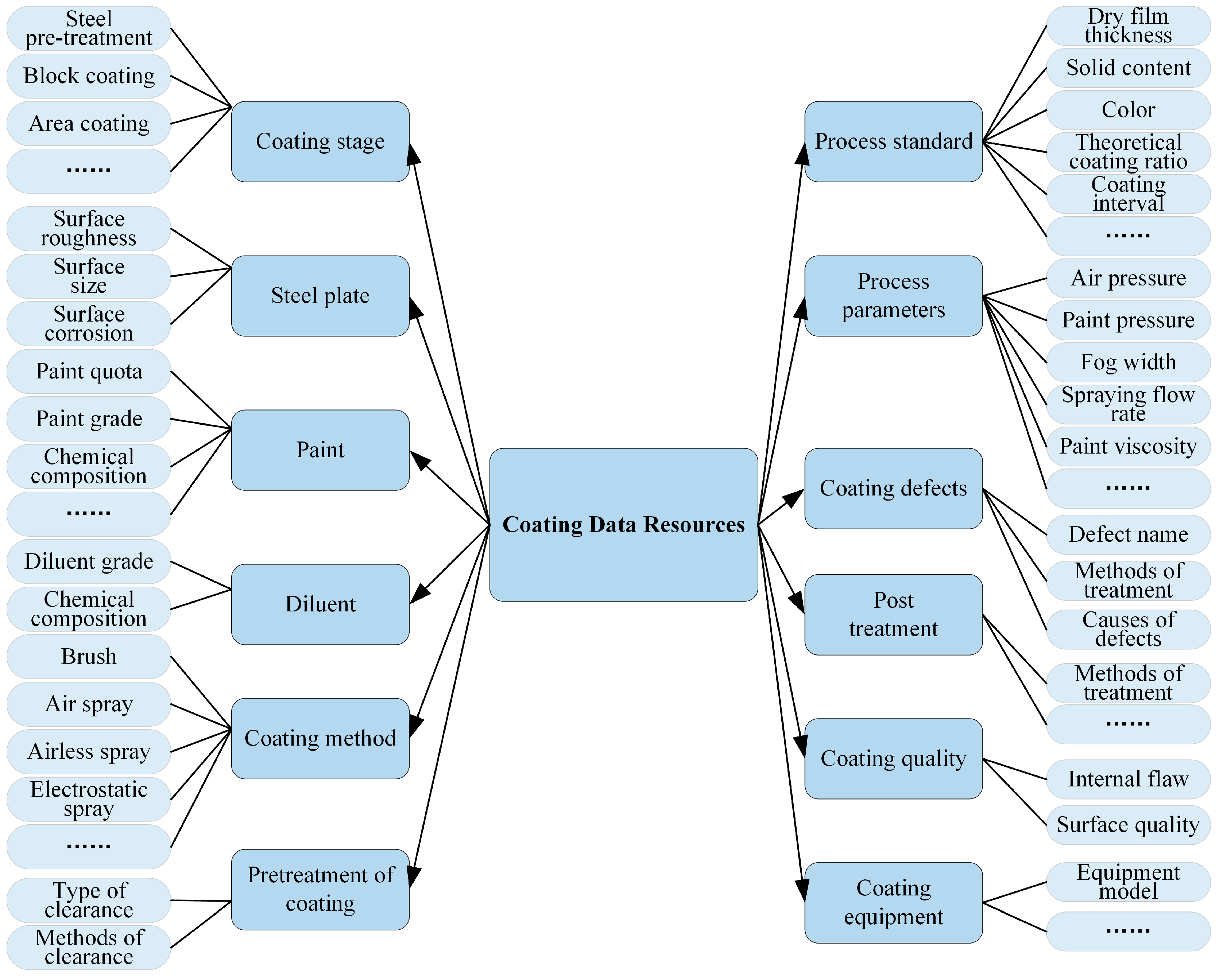
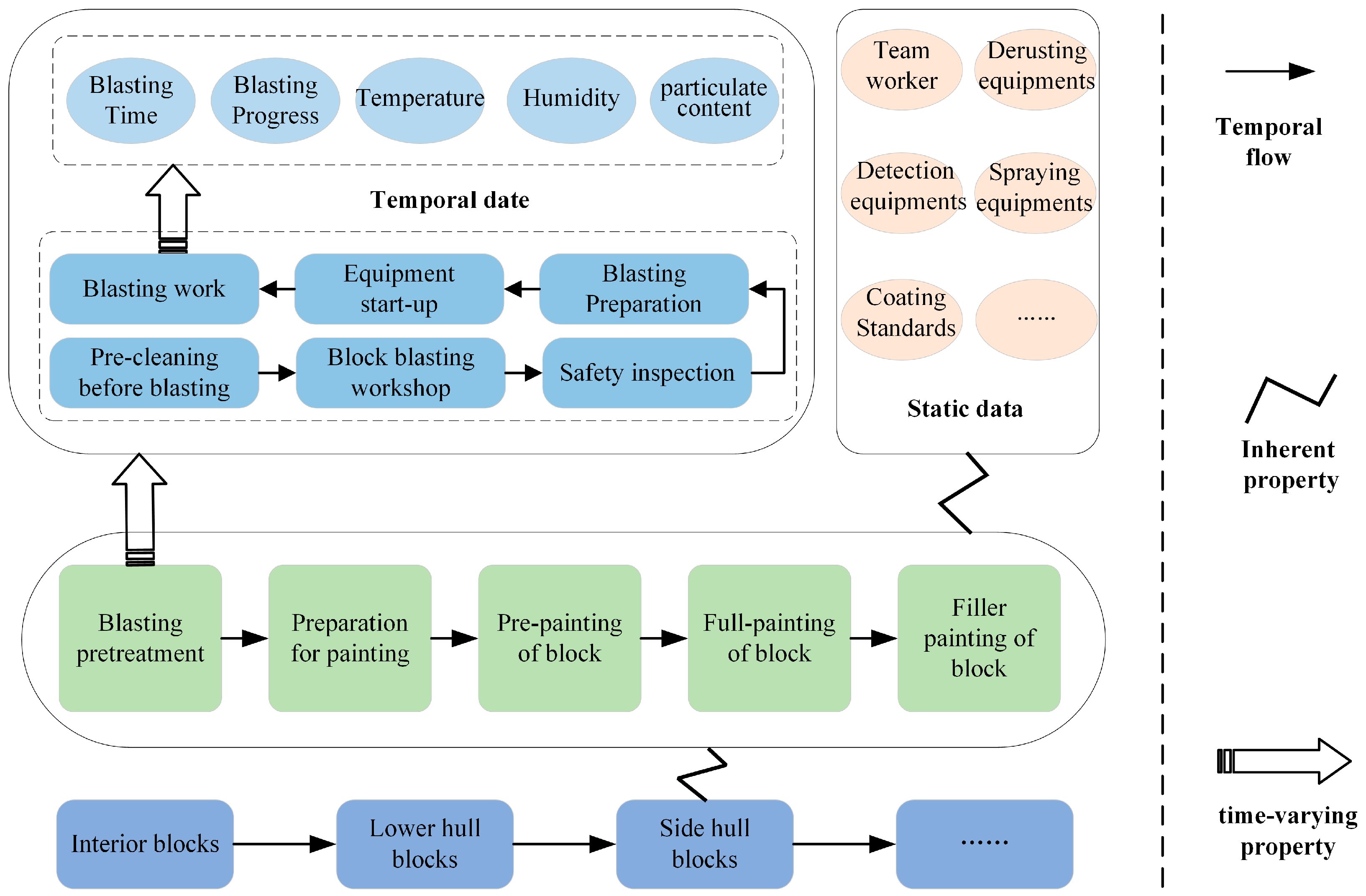

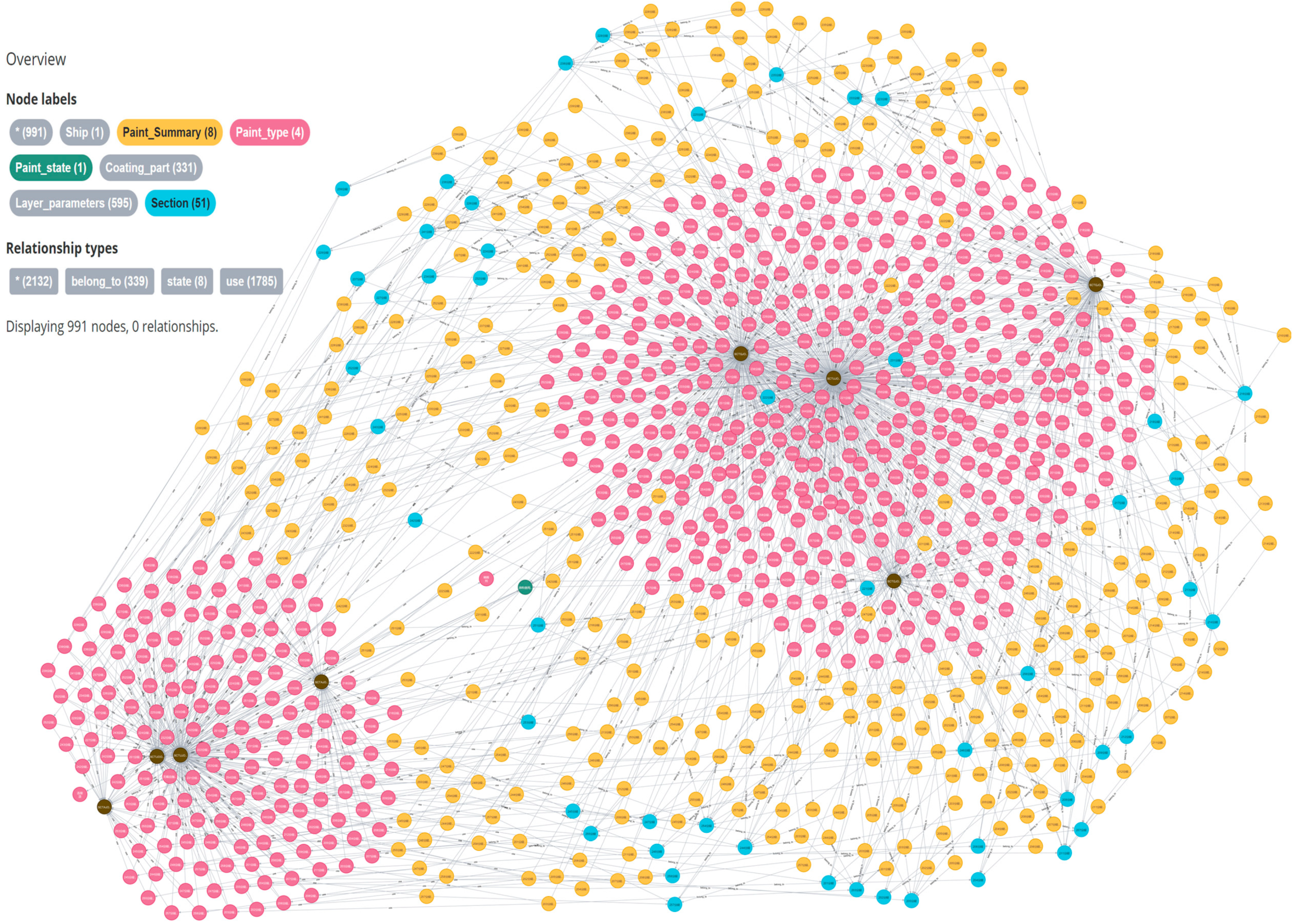

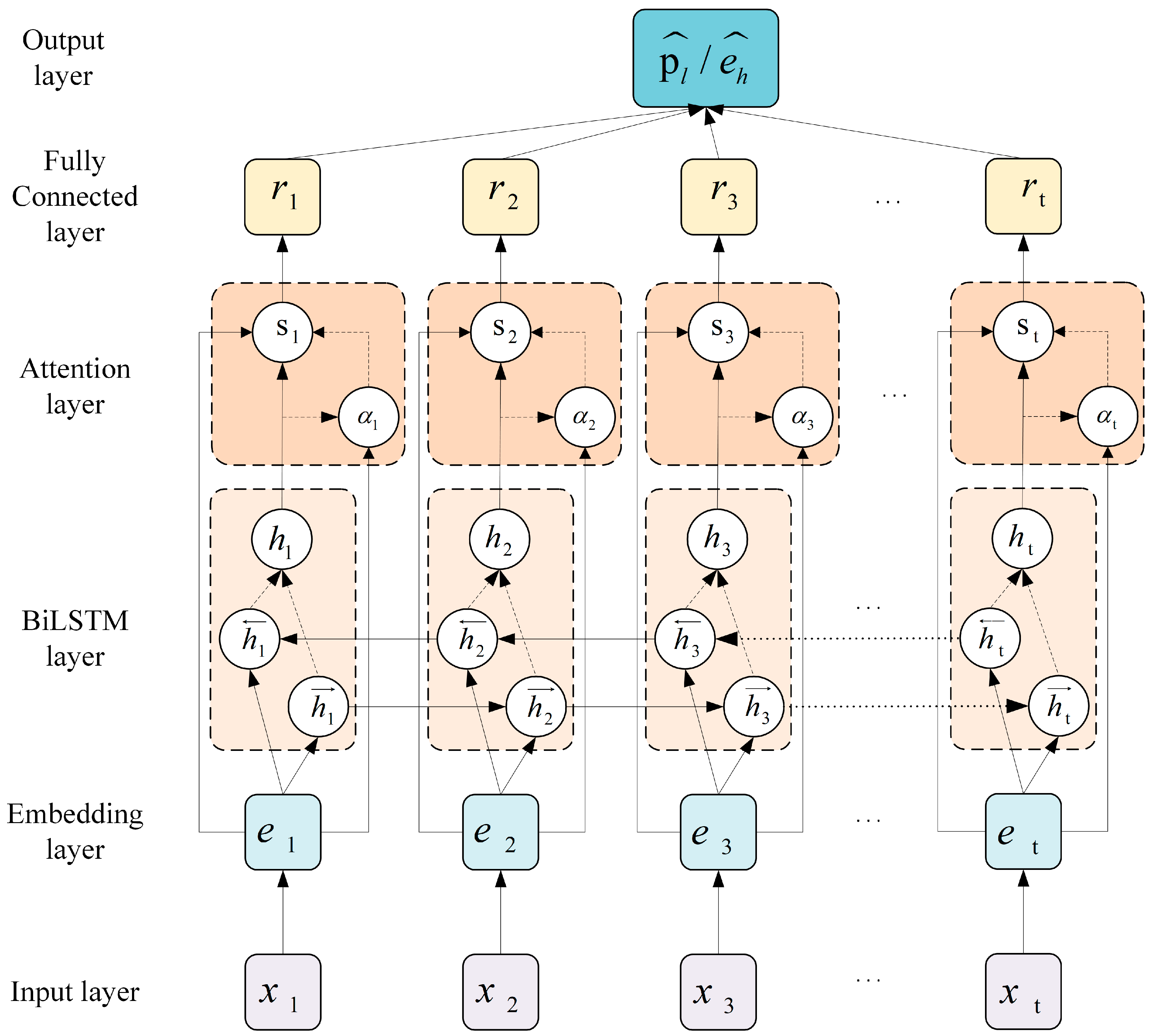

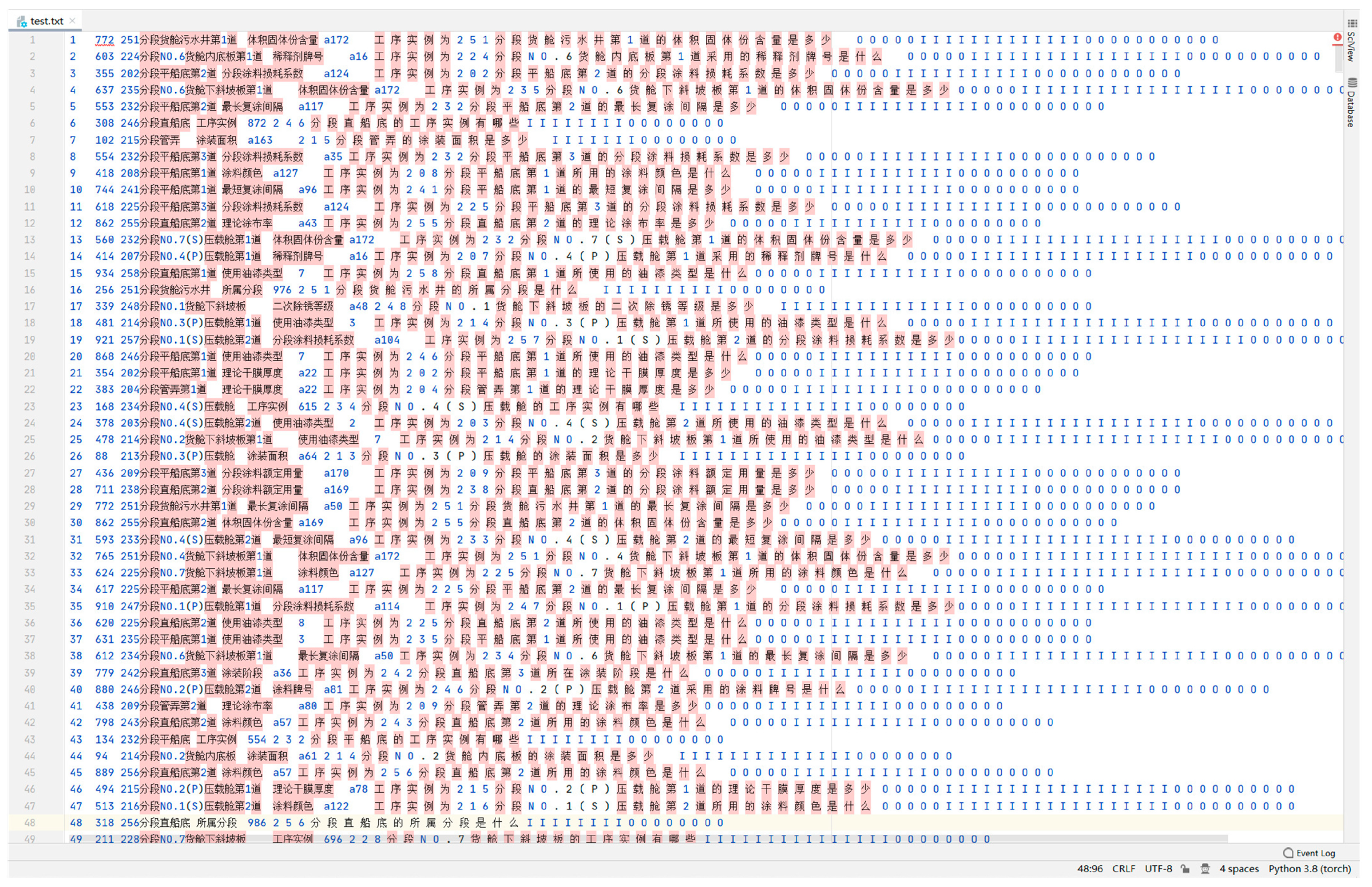
| Temporal Date | Comments |
|---|---|
| Planned task durations | Theoretical start and finish times for each step of the coating task |
| Coating progress | Actual start and completion times of the various steps of the coating tasks |
| Environmental parameters | Including temperature, humidity, and other environmental parameters that affect the quality of coating and work safety monitoring in real time |
| Harmful substance content | Levels of harmful substances monitored in real time, mainly volatile organic compounds (VOCs) and particulate matter |
| Spraying parameters | Real-time monitoring of spraying parameters including nozzle pressure, nozzle distance, spraying speed, etc. |
| Paint rheological properties | Real-time monitoring of paint rheological properties including viscosity, flow, rheological stress, etc. |
| Paint drying time | Real-time monitoring of the time from the end of spraying to paint drying |
| Coating thickness | Real-time monitoring of the thickness of the coating on the surface of the material after spraying. |
| Relationship Type | Relationship Name | Relationship Definition |
|---|---|---|
| Static relationship | Has | Indicates the set of basic inherent information such as coating object, coating process parameter, coating process specification, and coating package that the station has |
| Belong_to | Indicates the ownership relationship between entity nodes | |
| Is | Indicates the attribute–value relationship of an attribute node | |
| Use | Indicates the usage relationship between nodes | |
| Use_state | Annotations shared by several nodes | |
| Temporal relationship | FlowTo: T | Indicates the flow relationship between workstations and between tasks at time T |
| Involved: T | Indicates entity nodes such as personnel, equipment, etc., involved in the coating task at time T | |
| HasWork: T | Indicates that, at time T, there are tasks at the stations that are finished with coating | |
| Is: T | Indicates the value of the attribute parameter generated by the monitoring equipment, etc., in the coating task at time T |
| NO. | Name | Painting Station | Area | Method and Grade of 2nd Preparation | Paint Name | Coat S NO. | Dry Film Thickness (μm) | Total DFT (μm) | Loss Factor | QTY(L) |
|---|---|---|---|---|---|---|---|---|---|---|
| 1 | 201 | Bottom of a flat boat | 211 | B: Sa2.5 O: St3 | Jotaprime 510 | 1 | 150 | 395 | 1.7 | 72 |
| 201 | 211 | Safeguard Plus | 1 | 100 | 1.7 | 64 | ||||
| 201 | 211 | Seaforce 60 | 1 | 145 | 1.5 | 79 | ||||
| 2 | 201 | NO. 7 inner bottom plate | 165 | B: Sa2.5 O: St3 | Jotaprime 510 | 1 | 50 | 50 | 2 | 22 |
| 3 | 201 | Tube well | 245 | B: Sa2.5 O: St3 | Jotaprime 510 | 1 | 150 | 150 | 1.8 | 88 |
| 4 | 201 | NO. 5(p) ballast tank | 382 | B: Sa2.5 O: As per PSPC | Jotaprime 510 | 1 | 160 | 320 | 1.8 | 147 |
| 201 | 382 | Jotaprime 510 | 1 | 160 | 1.85 | 151 | ||||
| 5 | 201 | NO. 5(p) ballast tank | 382 | B: Sa2.5 O: As per PSPC | Jotaprime 510 | 1 | 160 | 320 | 1.8 | 147 |
| 201 | 382 | Jotaprime 510 | 1 | 160 | 1.85 | 151 | ||||
| … | … | … | … | … | … | … | … | … | … | … |
| Notations | Definitions |
|---|---|
| KG | knowledge graph |
| a fact, i.e., (head entity, relationship, tail entity) | |
| Q | a set of simple questions with ground truth facts |
| C | candidate fact set |
| M | total number of relationships in KG |
| N | total number of entities in KG |
| d | dimension of the embedding representations |
| embedding representations of all relationships in KG | |
| embedding representations of all entities in KG | |
| relation function, given , | |
| predicated relationship representation | |
| predicated entity representation | |
| HED | head entity detection model |
| head entity name tokens returned by the HED | |
| non-entity name tokens returned by the HED |
| Term 1 | Term 2 | Term 3 | Term 4 | Term 5 | |
|---|---|---|---|---|---|
| term 1 | |||||
| term 2 | |||||
| term 3 | |||||
| term 4 | |||||
| term 5 |
| Matrix Order | 1 | 2 | 3 | 4 | 5 | 6 | 7 | 8 | 9 | 10 | 11 | 12 | 13 |
|---|---|---|---|---|---|---|---|---|---|---|---|---|---|
| R.I. | 0 | 0 | 0.58 | 0.90 | 1.12 | 1.24 | 1.32 | 1.41 | 1.45 | 1.49 | 1.51 | 1.54 | 1.56 |
| Positive | Negative | |
|---|---|---|
| True | True Positive (TP) | True Negative (TN) |
| False | False Positive (FP) | False Negative (FN) |
| Each Term in the Joint Metric Distance | Keep Only the Accuracy of This Item |
|---|---|
| 0.728 | |
| 0.195 | |
| 0.730 | |
| 0.173 | |
| 0.435 |
| Algorithms | FB2M | FB5M | Block Coating Dataset |
|---|---|---|---|
| Bords et al. [53] | 0.627 | 0.639 | 0.741 |
| Yin et al. [24] | 0.683 (+8.9%) | 0.672 (+5.1%) | 0.793 (+7%) |
| KEQA-noEmbed [28] | 0.731 (+16.6%) | 0.726 (+13.6%) | 0.861 (+16.2%) |
| KEQA | 0.754 (+20.3%) | 0.749 (+17.2%) | 0.907 (+22.4%) |
| AHP-KEQA | 0.755 (+20.4%) | 0.754 (+17.9%) | 0.921 (+24.3%) |
Disclaimer/Publisher’s Note: The statements, opinions and data contained in all publications are solely those of the individual author(s) and contributor(s) and not of MDPI and/or the editor(s). MDPI and/or the editor(s) disclaim responsibility for any injury to people or property resulting from any ideas, methods, instructions or products referred to in the content. |
© 2023 by the authors. Licensee MDPI, Basel, Switzerland. This article is an open access article distributed under the terms and conditions of the Creative Commons Attribution (CC BY) license (https://creativecommons.org/licenses/by/4.0/).
Share and Cite
Bu, H.; Peng, Y.; Guo, Q.; Zhou, H. Knowledge Representation and Reuse of Ship Block Coating Based on Knowledge Graph. Coatings 2024, 14, 24. https://doi.org/10.3390/coatings14010024
Bu H, Peng Y, Guo Q, Zhou H. Knowledge Representation and Reuse of Ship Block Coating Based on Knowledge Graph. Coatings. 2024; 14(1):24. https://doi.org/10.3390/coatings14010024
Chicago/Turabian StyleBu, Henan, Yang Peng, Qinzheng Guo, and Honggen Zhou. 2024. "Knowledge Representation and Reuse of Ship Block Coating Based on Knowledge Graph" Coatings 14, no. 1: 24. https://doi.org/10.3390/coatings14010024
APA StyleBu, H., Peng, Y., Guo, Q., & Zhou, H. (2024). Knowledge Representation and Reuse of Ship Block Coating Based on Knowledge Graph. Coatings, 14(1), 24. https://doi.org/10.3390/coatings14010024





